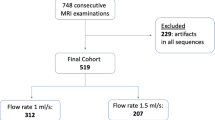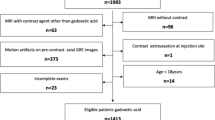Abstract
Purpose
To identify predictive factors for truncation artifacts (TAs) in the arterial phase of Gd-EOB-DTPA-enhanced MRI in a multicenter study in Japan.
Materials and methods
Data on patient factors (age, sex, weight, presence of viral hepatitis, and other conditions) and imaging parameters (e.g., triggering, voxel size, matrix, k-space ordering, acquisition time, reduction factor, flip angle, fat suppression, field strength, injection rate, and saline volume) were obtained. Univariate and multivariate analyses were performed to investigate the correlation of these parameters.
Results
We evaluated 1444 patients from 43 institutions who were scanned using GE, Siemens, Philips, or Toshiba MRI equipment (501, 354, 349, and 240 patients, respectively). The total incidence of TAs was 12.5% (17.2, 3.6, 15.7, and 12.1%, respectively). The matrix [odds ratio (OR) 0.13], flip angle (OR 5.77), use of fat suppression (OR 0.106), and field strength (OR 0.092) used in the Philips equipment significantly increased the incidence of TAs in MRI examination.
Conclusions
The incidence of TAs in the arterial phase is influenced by several patient factors and imaging parameters. Especially, Siemens and Toshiba equipment had a significantly lower frequency of TAs. This indicates that such vendor-specific technology used in the dynamic sequence may have a TA-resistant effect.



Similar content being viewed by others
Change history
04 February 2021
In the original publication of this paper, results section has been mistakenly published without consistency with Tables.
Abbreviations
- CI:
-
Confidence interval
- Gd-EOB-DTPA:
-
Gadolinium-ethoxybenzyl-diethylenetriamine pentaacetic acid
- HBV:
-
Hepatitis B virus
- HCV:
-
Hepatitis C virus
- OR:
-
Odds ratio
- TA:
-
Truncation artifact
References
Kudo M. Will Gd-EOB-MRI change the diagnostic algorithm in hepatocellular carcinoma? Oncology. 2010;78:87–93. https://doi.org/10.1159/000315235.
Fowler KJ, Brown JJ, Narra VR. Magnetic resonance imaging of focal liver lesions: approach to imaging diagnosis. Hepatology. 2011;54:2227–37. https://doi.org/10.1002/hep.24679.
Tang A, Bashir MR, Corwin MT, Cruite I, Dietrich CF, Do RKG, Ehman EC, Fowler KJ, Hussain HK, Jha RC, Karam AR, Mamidipalli A, Marks RM, Mitchell DG, Ohliger MA, Morgan TA, Shah A, Vu KN, Sirlin CB. Evidence supporting LI-RADS major features for CT- and MR imaging-based diagnosis of hepatocellular carcinoma: a systematic review. Radiology. 2018;286:29–48. https://doi.org/10.1148/radiol.2017170554.
Mitchell DG, Bruix J, Sherman M, Sirlin CB. LI-RADS (Liver Imaging Reporting and Data System): summary, discussion, and consensus of the LI-RADS Management Working Group and future directions. Hepatology. 2015;61:1056–65. https://doi.org/10.1002/hep.27304.
Elsayes KM, Hooker JC, Agrons MM, Kielar AZ, Tang A, Fowler KJ, Chernyak V, Bashir MR, Kono Y, Do RK, Mitchell DG, Kamaya A, Hecht EM, Sirlin CB. 2017 Version of LI-RADS for CT and MR imaging: an update. Radiographics. 2017;37:1994–2017. https://doi.org/10.1148/rg.2017170098.
van der Pol CB, Lim CS, Sirlin CB, McGrath TA, Salameh JP, Bashir MR, Tang A, Singal AG, Costa AF, Fowler K, McInnes MDF. Accuracy of the liver imaging reporting and data system in computed tomography and magnetic resonance image analysis of hepatocellular carcinoma or overall malignancy-a systematic review. Gastroenterology. 2019;156:976–86. https://doi.org/10.1053/j.gastro.2018.11.020.
Davenport MS, Caoili EM, Kaza RK, Hussain HK. Matched within-patient cohort study of transient arterial phase respiratory motion-related artifact in MR imaging of the liver: Gadoxetate disodium versus gadobenate dimeglumine. Radiology. 2014;272:123–31. https://doi.org/10.1148/radiol.14132269.
Bashir MR, Castelli P, Davenport MS, Larson D, Marin D, Hussain HK, Jaffe TA. Respiratory motion artifact affecting hepatic arterial phase MR imaging with gadoxetate disodium is more common in patients with a prior episode of arterial phase motion associated with gadoxetate disodium. Radiology. 2015;274:141–8. https://doi.org/10.1148/radiol.14132269.
Pietryga JA, Burke LM, Marin D, Jaffe TA, Bashir MR. Respiratory motion artifact affecting hepatic arterial phase imaging with gadoxetate disodium: examination recovery with a multiple arterial phase acquisition. Radiology. 2014;271:426–34. https://doi.org/10.1148/radiol.13131988.
Ikeno H, Kobayashi S, Kozaka K, Ogi T, Inoue D, Yoneda N, Yoshida K, Ohno N, Gabata T, Kitao A. Relationship between the degree of abdominal wall movement and the image quality of contrast-enhanced MRI: semi-quantitative study especially focused on the occurrence of transient severe motion artifact. Jpn J Radiol. 2020;38:165–77. https://doi.org/10.1007/s11604-019-00896-2.
Motosugi U, Takehara Y. Motion and solution in hepatobiliary agent-enhanced dynamic MRI: solid evidence and unanswered question. Jpn J Radiol. 2020;38:99–100. https://doi.org/10.1007/s11604-019-00900-9.
Motosugi U, Ichikawa T, Sou H, Sano K, Ichikawa S, Tominaga L, Araki T. Dilution method of gadolinium ethoxybenzyl diethylenetriaminepentaacetic acid (Gd-EOB-DTPA)-enhanced magnetic resonance imaging (MRI). J Magn Reson Imaging. 2009;30:849–54. https://doi.org/10.1002/jmri.21913.
Haradome H, Grazioli L, Tsunoo M, Tinti R, Frittoli B, Gambarini S, Morone M, Motosugi U, Colagrande S. Can MR fluoroscopic triggering technique and slow rate injection provide appropriate arterial phase images with reducing artifacts on gadoxetic acid-DTPA (Gd-EOB-DTPA)-enhanced hepatic MR imaging? J Magn Reson Imaging. 2010;32:334–40. https://doi.org/10.1002/jmri.22241.
Concato J, Feinstein AR. Monte Carlo methods in clinical research: applications in multivariable analysis. J Investig Med. 1997;45:394–400.
Tamada T, Ito K, Sone T, Yamamoto A, Yoshida K, Kakuba K, Tanimoto D, Higashi H, Yamashita T. Dynamic contrast-enhanced magnetic resonance imaging of abdominal solid organ and major vessel: comparison of enhancement effect between Gd-EOB-DTPA and Gd-DTPA. J Magn Reson Imaging. 2009;29:636–40. https://doi.org/10.1002/jmri.21689.
Kim YK, Lin WC, Sung K, Raman SS, Margolis D, Lim Y, Gu S, Lu D. Reducing artifacts during arterial phase of gadoxetate disodium-enhanced mr imaging: dilution method versus reduced injection rate. Radiology. 2017;283:429–37. https://doi.org/10.1148/radiol.2016160241.
Tamada T, Ito K, Yoshida K, Kanki A, Higaki A, Tanimoto D, Higashi H. Comparison of three different injection methods for arterial phase of Gd-EOB-DTPA enhanced MR imaging of the liver. Eur J Radiol. 2011;80:e284–e288288. https://doi.org/10.1016/j.ejrad.2010.12.082.
Tanimoto A, Higuchi N, Ueno A. Reduction of ringing artifacts in the arterial phase of gadoxetic acid-enhanced dynamic MR imaging. Magn Reson Med Sci. 2012;11:91–7. https://doi.org/10.2463/mrms.11.91.
Svensson J, Petersson JS, Ståhlberg F, Larsson EM, Leander P, Olsson LE. Image artifacts due to a time-varying contrast medium concentration in 3D contrast-enhanced MRA. J Magn Reson Imaging. 1999;10:919–28.
Author information
Authors and Affiliations
Contributions
Guarantors of integrity of entire study: MT and TM. Study concepts/study design or data acquisition or data analysis/interpretation: all authors. Manuscript drafting or manuscript revision for important intellectual content: all authors. Approval of final version of submitted manuscript: all authors. Agrees to ensure any questions related to the work are appropriately resolved: all authors. Literature research: MT and KS. Clinical studies: all authors. Statistical analysis: MT. Manuscript editing: MT, KS, KI, and TM.
Corresponding author
Ethics declarations
Conflict of interest
MT, KS, HO, SG, AH, HI, HH, KI, and TM have no disclosures and funding.
Additional information
Publisher's Note
Springer Nature remains neutral with regard to jurisdictional claims in published maps and institutional affiliations.
Electronic supplementary material
Below is the link to the electronic supplementary material.
About this article
Cite this article
Tsurusaki, M., Sofue, K., Onishi, H. et al. Predictive factors of truncation artifacts in the arterial phase of Gd-EOB-DTPA-enhanced MRI: a nationwide multicenter study. Jpn J Radiol 39, 165–177 (2021). https://doi.org/10.1007/s11604-020-01052-x
Received:
Accepted:
Published:
Issue Date:
DOI: https://doi.org/10.1007/s11604-020-01052-x




